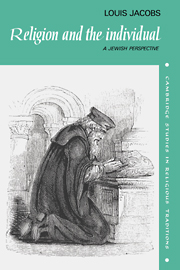Book contents
- Frontmatter
- Contents
- Preface
- List of abbreviations
- 1 Individual significance
- 2 Self-realization as a religious value
- 3 Attitudes to life and death
- 4 Family relationships
- 5 Loving the neighbour
- 6 Communal obligations
- 7 God and the soul
- 8 Does a person's body belong to God?
- 9 Worship with the body
- 10 God and personal freedom
- 11 Immortality
- 12 Conclusion: A question of emphasis
- Glossary
- Notes
- Bibliography
- Index
9 - Worship with the body
Published online by Cambridge University Press: 11 October 2009
- Frontmatter
- Contents
- Preface
- List of abbreviations
- 1 Individual significance
- 2 Self-realization as a religious value
- 3 Attitudes to life and death
- 4 Family relationships
- 5 Loving the neighbour
- 6 Communal obligations
- 7 God and the soul
- 8 Does a person's body belong to God?
- 9 Worship with the body
- 10 God and personal freedom
- 11 Immortality
- 12 Conclusion: A question of emphasis
- Glossary
- Notes
- Bibliography
- Index
Summary
In Judaism, as in other religions, the tensions, even the dichotomy, between body and soul are certainly not unknown yet it is axiomatic in every version of a faith correctly described as the religion of doing God's will that the body is to be brought into play at every stage of the religious life. The mitzvot, the precepts of the Torah, to be sure, are not limited to the performance of bodily actions. Some of the mitzvot such as the love of God and the neighbour have to do with emotional, psychological states. But the majority of the mitzvot are in the nature of commands to carry out this or that physical act and to refrain from this or that physical act. The hugely influential, Sufiinspired, mediaeval classic, Duties of the Heart, by Bahya Ibn Pakudah (twelfth century) appeals for greater inwardness in the religious life. In Bahya's terminology adopted from the Sufis, the mitzvot are divided into ‘duties of the heart’ and ‘duties of the limbs’ and it is the former that need to be emphasized. All very true, and yet even Bahya, the most determined advocate of inwardness, cannot, and does not, ignore the ‘duties of the limbs‘. We know very little about Bahya's life but we do know that he was a strictly observant Jew and a dayan (a judge) to boot.
A typical Talmudic saying has it that there are 248 positive precepts of the Torah corresponding to the 248 ‘limbs’ (i.e. parts) of the human body and there are 365 negative precepts corresponding to the 365 days in the solar years.
- Type
- Chapter
- Information
- Religion and the IndividualA Jewish Perspective, pp. 64 - 78Publisher: Cambridge University PressPrint publication year: 1992



